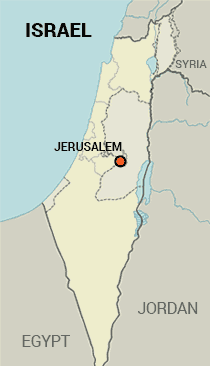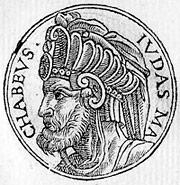
Jesus: Origins of Christianity:
Jerusalem and the Early Followers of Jesus
A month after his own death in 14 CE, Augustus Caesar was declared a god by the Roman Senate and was worshipped, with statues venerating him throughout the empire, including in Jerusalem.
Pax Romana meant that it was by the will of the gods that Rome ruled, because of its virtue, strength and nobility. The Jews, on the other hand, had their own destiny, which many believed reflected the one true god’s plan, worked out through a revealed sense of history in the apocalyptic tradition. For many Jews 2,000 years ago, political liberty was a religious ideal. They were activists for the “kingdom of god.”

In 459 BCE Ezra led about 50,000 Israelite exiles living in Babylon back to Jerusalem where he re-established the Laws of Moses. Fourteen years later Nehemiah, cupbearer to Artaxerxes the Persian emperor, was appointed governor of Judah. He further rebuilt Jerusalem and enforced Ezra’s ban on intermarriage between the Jews and others. Jerusalem remained a backwater. It was not on any of the main trade routes: the caravans that stopped at Petra or Gaza had no reason to go to Jerusalem, which lacked the raw materials to develop its own industry. In 334 BCE Alexander crossed the Dardanelles (ancient Hellespont) in northwestern Turkey, extending the Greek empire from Egypt to Persia. So now not only Persian and Babylonian but also Greek influences entered Israel. During the wars of his six successors, Judea was constantly invaded by one army after the other, with Jerusalem itself changing hands six times between 320 and 301 BCE.
During the wars of his six successors, Judea was constantly invaded by one army after the other, with Jerusalem itself changing hands six times between 320 and 301 BCE.
Jews were divided in their response to the Greeks. Some felt at home in their world and became pioneers of their new ideas in Jerusalem. Others found this foreign influence extremely threatening and wanted to maintain the old laws and customs. This developed into a serious conflict with some Jews wanting to convert Jerusalem into a Greek-style city called “Antioch in Judea.” For them Hellenism was a perfect vehicle for Judaic ideas, while others, in contrast, saw the Greek ways and philosophies as entirely contrary to their heritage. At about the year 200 Ptolemy Soter (Savior) extended his boundaries northward from Egypt to include Jerusalem and Judea. By this time, though, there was already a Jewish diaspora in Egypt and Greek had become their native language. Thus, the first translation of the Bible was the famous Greek version known as the Septuagint, translated in stages between the third and second centuries BCE in Alexandria.

The Ptolemys ruled until 198 BCE, when they were forced to give way to the Seleucid Greeks from Syria. The Seleucids’ Hellenization was much more oppressive, much less tolerant of Jewish religion and identity. Antiochus IV issued edicts against the practice of Judaism that were extreme and unprecedented, and atrocities occurred: mothers who circumcised their sons were flung from Jerusalem’s walls to their deaths; a ninety-year-old man named Eliezar was executed for his refusal to eat pork. The culmination came when Antiochus deliberately desecrated the Temple. As you can imagine, these actions galvanized the people against the Greeks. A small band of warriors under Judas the Maccabee—his name literally means Judas the hammer—began a guerrilla war against them. Finally in 164 BCE they managed to retake the Temple and, while holding off the Greek armies, proceeded to re-purify and rededicate it.
The Maccabean Revolt was largely successful in creating a new independent Jewish state ruled by the descendants of Judas the Maccabee: the Hasmonean kings. A synthesis of Jewish and Greek thought prevailed, though many Jews rebelled against it. The Hasmonean rule lasted about a century until two heirs of the dynasty started fighting each other over who would be the next king. This came to a head in the year 63 BCE at a time when the great Roman general Pompeii was in Damascus. The leaders of Jerusalem appealed to Pompeii for help. The Romans came to help but, unfortunately for the Jews, they stayed.
The Maccabean Revolt was largely successful in creating a new independent Jewish state ruled by the descendants of Judas the Maccabee: the Hasmonean kings
In 42 BCE Octavian’s adopted father, Julius Caesar, was posthumously recognized as a god, so Octavian improved his stature, calling himself Divi filius, “Son of god.” In 27 BCE he became the first emperor, “the exalted” Augustus, of the Roman Empire, which extended from Spain and Britain in the west to the Persian Gulf in the east, where the land of Judaea on the eastern Mediterranean became important as a point of entry.

A month after his own death in 14 CE, Augustus was himself declared a god by the Roman Senate and was worshipped, with statues venerating him throughout the empire, including in Jerusalem. Pax Romana meant that it was by the will of the gods that Rome ruled, because of its virtue, strength and nobility. The Jews, on the other hand, had their own destiny which many believed reflected the one true god’s plan, worked out through a revealed sense of history in the apocalyptic tradition. For many Jews 2,000 years ago, political liberty was a religious ideal. They were activists for the “kingdom of God.”
Revolutionary thoughts were exacerbated by people’s dissatisfaction with the greed and perversions of the infamous Herod the Great and his expansive building program in the Roman style. This included rebuilding the Temple at Jerusalem which soon became for many Jews a symbol not of national identity, hope and God’s will, but of corruption and evil. Some criticized the way the priests ran the temple, often benefiting themselves at the expense of their people. During the time of both John the Baptist and Jesus of Nazareth, Herod’s son, Herod Antipas, succeeded his father and ruled over Galilee from 4 BCE to 39 CE.
The Early Followers of Jesus

For many Jews 2,000 years ago, political liberty was a religious ideal. They were activists for the “kingdom of God.”
Jesus survived after his death through his followers, who initially were centered in Jerusalem and headed by his brother James. They remained part of mainstream Jewry and would have had no thought of starting a new religion.
There can be no doubt that his ignominious, tragic and untimely death left those who loved him and wanted to learn from him totally devastated. Initially his followers would have gathered to recall and repeat his words as they remembered them and to emulate his behavior as best they could. Some scholars suggest that the shock of his death left his followers so devastated that they believed that they had misunderstood the role of their Messiah. During his lifetime Jesus followed the Jewish messianic tradition and eschatology, aiming to restore a just kingdom to the Jews on earth.
Now they believed it was the Kingdom of God that he would herald. Expecting him to return again in triumph at any minute, bringing with him the end of the world, they lived in the strong sense of his presence—in the form of the Holy Spirit.
“…ritual outside the established Jewish custom was minimal: consisting of baptism and the Eucharist meal celebrated in people’s homes. The early Church followers appear also to have gathered in small groups, probably each around a particular apostle, where they would repeat and discuss such sayings and teachings of Jesus as they could remember. This early practice reflects an inner spiritual tradition still current in parts of the East, where, in addition to observing the external religious law, certain students also receive wisdom handed down through a chain of masters.” The Marketing of Christianity: The Evolution of Early Christian Doctrine, Institute for Cultural Research, London, 2000.
Jewish Zealots led a rebellion against the power of Rome. This “Great Revolt” (66–73) was a disaster…
Then further tragedy occurred. About forty years after the death of Jesus, several Jewish Zealots led a rebellion against the power of Rome. This “Great Revolt” (66–73) was a disaster; it resulted in the destruction of the Jewish Temple and of Jerusalem itself, which was burned to the ground. The historian Josephus estimated that one million one hundred thousand Jews perished in the siege of Jerusalem alone. Galilee, where Jesus taught, was the home of the Jewish resistance and so suffered badly—the Romans killed and pillaged without mercy. According to Josephus in Wars III. iv, I. x. 9.: “One could see the whole lake red with blood and covered with corpses, for not a man escaped.”
The might of Rome celebrated this victory with the building of the Arch of Titus in Rome, and, to further emphasize Pax Romana, the Colosseum in Rome was built from the booty of the Jewish Temple. To the Jews this was catastrophic. It was physical and concrete evidence that Rome’s gods were more powerful than Yahweh. The followers of Jesus were still lamenting their teacher’s demise at the hands of the Romans and now had to deal with the Temple and Israel’s destruction again by Roman hands. Some scholars suggest that it was as a response to both Jesus’ death and these tragic and horrific events that the idea of their teacher’s resurrection came about.

The idea of resurrection was not new in Judaism, however, and may well have been absorbed originally from the Zoroastrians. Daniel, who was advisor to the Persian emperor Darius the Great, was the first Jewish prophet to refer to it, and it was believed in by Hillel and his followers. Hence the idea was familiar to the early followers of Jesus, who might well have turned to it as consolation: god would raise his faithful servant Jesus from the dead, as he restored to life others who had honored him in their lives.
After the catastrophe of the Great Revolt, Jews were expelled from Jerusalem and the Temple destroyed. The early church in Jerusalem all but disappeared and no written records survived of the sayings and doings of Jesus. According to Dr. Hugh Schonfield in his book The Passover Plot, from this time on his teaching would unfortunately be remembered only in fragments and would unavoidably be subject to interpretation by people with different biases: “depriving the Church … of authoritative guidance in matters of faith, and opening the door for the increasing intrusion of alien beliefs.”
By the year 65 CE believers in Jesus lived in all the major cities of the eastern Roman empire.
Perhaps in part due to the lack of authentic documentation on Jesus’s life and teaching, within a decade or two after his death believers in the Messiah as the crucified Jesus existed in Syria, the eastern Mediterranean and as far west as Rome. Some continued to follow Jewish Orthodoxy, and some were Gentiles. By the year 65 CE, believers in Jesus lived in all the major cities of the eastern Roman Empire. Gradually separating themselves from the local Jewish community, they formed separate communities, meeting in households throughout the many cities. They were dubbed Christians from the Greek word Cristos, a Greek translation of the Hebrew title meaning messiah—“the anointed one.” From the time of emperor Nero, they were viewed as a distinct group by outsiders. Looking for scapegoats upon whom to blame the fire in Rome in 64 CE, Nero focused his attention on the Christians.

Separation from Judaism took place over a long period and varied from place to place. In Antioch and Constantinople, for example, Christians were participating within the Jewish community and attending Jewish festivals as late as the fourth and fifth centuries. At the other end of the spectrum, in the communities founded by Saul of Tarsus, who would become known as Paul the Apostle, the social separation had already taken place by the middle of the first century.
